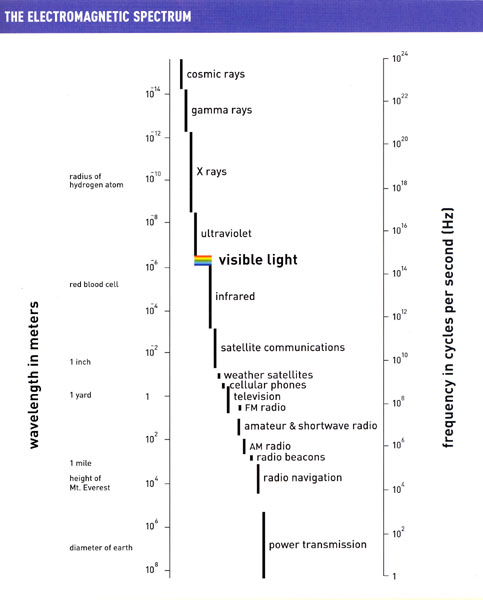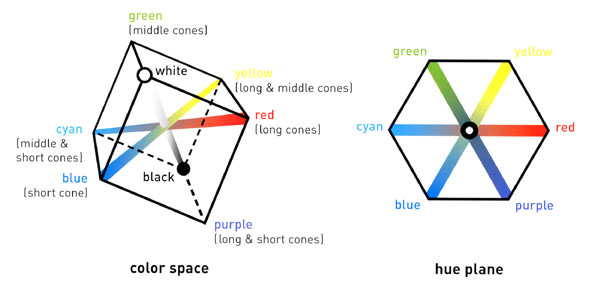Visual Perception
Schedule
Internet
Resources
Lecture:
- How do we see & How does how we see affect what we are seeing?
- What exactly are we seeing?
- Define Vision
- Define Visual Perception
Nature
of Light
A light wave consists of energy in the form of electric and magnetic
fields. The fields vibrate at right angles to the direction of movement
of the wave, and at right angles to each other. Because light has both
electric and magnetic fields, it is also referred to as electromagnetic
radiation.

Topics:
Electromagnetic Spectrum
Electromag. energy
Particulate/Wave
Frequency/intensity
Incandecent / luminescent
Nature of Color
Light waves also come in many frequencies. The frequency is the number
of waves that pass a point in space during any time interval, usually
one second. It is measured in units of cycles (waves) per second, or
Hertz (Hz). The frequency of visible light is referred to as color, and
ranges from 430 trillion Hz, seen as red, to 750 trillion Hz, seen as
violet. Again, the full range of frequencies extends beyond the visible
spectrum, from less than one billion Hz, as in radio waves, to greater
than 3 billion billion Hz, as in gamma rays.

Topics:
Color Spectrum
Frequency
Nature of primary/complimentary
Reflective characteristics of surface / object
Experiments:
· Afterimages
· Prisms - glass/water/oil
· computer - gamut/ spectrum/sliders
Lenses - bending light rays/ virtual and real images
When light rays reach an angulated surface it causes the light rays to bend. This is called refraction.
Light passing through a convex lens, the light rays bend toward the
center:

Light passing through a concave lens, the light rays bend away from
the center:

Topics/Experiments:
Obscura
Concave
Convex
Mirrors
Real / Virtual Images
Lens Elements in Cameras
When light enters the eye, it first passes through the cornea, then the aqueous humor, lens and vitreous humor. Ultimately it reaches the retina, which is the light-sensing structure of the eye. The retina contains two types of cells, called rods and cones. Rods handle vision in low light, and cones handle color vision and detail. When light contacts these two types of cells, a series of complex chemical reactions occurs. The chemical that is formed (activated rhodopsin) creates electrical impulses in the optic nerve. Rhodopsin is a mixture of a protein called scotopsin and 11-cis-retinal -- the latter is derived from vitamin A (which is why a lack of vitamin A causes vision problems). Rhodopsin decomposes when it is exposed to light because light causes a physical change in the 11-cis-retinal portion of the rhodopsin, changing it to all-trans retinal. This first reaction takes only a few trillionths of a second. The 11-cis-retinal is an angulated molecule, while all-trans retinal is a straight molecule. This makes the chemical unstable. Rhodopsin breaks down into several intermediate compounds, but eventually (in less than a second) forms metarhodopsin II (activated rhodopsin). This chemical causes electrical impulses that are transmitted to the brain and interpreted as light.
Topics:
Vision - image or information
Components of the eye
Functions of rod/cone - pigments
Pupil
Fovea
Retina
Cone/Rod
Optic Nerve
Pathways of signals to and in the brain
Thalamus
Visual Cortex
Higher Level ProcessingPeriphery
Center/surroundexampleA
exampleB
· Perspective
· Depth/Distance
· Motion
· Contours
· Edges· edge enhancements
· Figure / ground
Experiments:
· blind spot
· depth perception
· Stereo Stereopsis
Persistence of Vision
· Zoetrope / phenakistoscope
· flip books / Finger animations
Introduction to Perceptual
Apparatus
The works that I am presenting express for me the proposition that a work of art is not exclusively an object of passive observation (or the 6-10 second experience of an artists rendition of a pre perceived experience, selection, documentation or framing but, a collaborative engagement and attention to a physical, political, and/or cultural aspect of the world that then potentially produces an aesthetic experience shared by both the participant and the artist.
Our experiences or perceptions are influenced by what we are, how our bodies function, our senses. The phenomenological processes at play in our bodies and the universe as well as the neurological processes and pathways transmitting sensory information form the basis of judgments, opinions, ideas, memories and experiences.
As an artist, my primary concerns are perceptual experience and the construction of meaning. By exploring the impact of altered or manipulated vision through a series of optical devices constructed to restrict or enhance the participants experience of seeing, this body of work invites the viewer to consider what it means to see or generally to perceive ones own experience through the work of art. By disrupting the visual apparatus, my thought was that I am altering the relationship between the perception, the means of perception and the stimulus thus altering the point of view which opens the viewer to a new interpretation of their surroundings and their experience. These optical forms operate as filters between the participant / performer and experience.
In my own investigation of the limitations of static or representational forms of art these optical devices provide a means to explore the relationship between an experience or the memory of an experience and it’s translation into a work of art.
Visual Literacy



